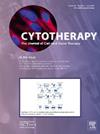ATLG对儿童造血干细胞移植后CD4+ t细胞重建的影响:一项详细的免疫分析研究
IF 3.2
3区 医学
Q2 BIOTECHNOLOGY & APPLIED MICROBIOLOGY
引用次数: 0
摘要
移植抗宿主病(GvHD)预防对造血干细胞移植(HSCT)后免疫重建(IR)的影响。具体来说,抗T淋巴细胞球蛋白(ATLG)延迟CD4+ T细胞重建。然而,ATLG改变CD4+ t细胞区室组成的机制仍然难以捉摸。目的:通过整合先进和高度标准化的流式细胞仪面板,无监督聚类分析,机器学习方法和分子生物学技术,解剖ATLG对CD4+ T细胞的影响。结果:我们用机器学习方法分析了94名儿科患者的hsct后IR。ATLG暴露导致影响CD4+ t细胞计数的最相关变量。严重联合免疫缺陷/近期胸腺移植物(SCID/RTE)和CD4 PERISCOPE EuroFlow抗体检测应用于急性淋巴细胞白血病患者亚队列。无监督聚类分析显示,在第一个月,与未接受atlg治疗的患者相比,接受atlg治疗的hsct后CD4+ naïve T细胞和rte显著减少,包括接受移植后环磷酰胺治疗的单倍体移植受体。在非atlg患者中,残余的受体来源细胞对RTE室有显著贡献,而在atlg治疗的患者中,RTE是供体来源的。此外,在非atlg患者中,早期rte和CD4+ T细胞计数与输注的CD3+ T细胞/kg相关。骨髓和t细胞受体切除环(TREC)分析显示,ATLG治疗不影响早期t细胞成熟。体外测试显示,ATLG暴露后naïve/RTE CD4+分化为效应亚群,流式细胞术和RNA测序证实了这一点。讨论:我们的数据显示ATLG诱导外周血CD4+ naïve/RTE t细胞区室的伴随分化和耗损。总之,这些发现表明,与未接受ATLG治疗的患者不同,ATLG治疗后naïve t细胞重建延迟,因为它只依赖于胸腺成熟。本文章由计算机程序翻译,如有差异,请以英文原文为准。
Impact of ATLG on CD4+ T-cell reconstitution after HSCT in children: a detailed immune profiling study
Introduction
Graft versus host disease (GvHD) prophylaxis impacts on post–hematopoietic stem cell transplantation (HSCT) immune reconstitution (IR). Specifically, anti-T lymphocyte globulin (ATLG) delays CD4+ T cell reconstitution. However, the mechanism by which ATLG alters the composition of CD4+ T-cell compartments remains elusive.
Aims
Dissect the impact of ATLG on CD4+ T cells by integrating advanced and highly standardized flow cytometric panels, unsupervised clustering analysis, machine learning approaches, and molecular biology techniques.
Results
We analyzed post-HSCT IR in 94 pediatric patients with a machine learning approach. ATLG exposure resulted in the most relevant variable affecting CD4+ T-cell counts. Severe combined immunodeficiency/recent thymic emigrant (SCID/RTE) and CD4 PERISCOPE EuroFlow antibody panels were applied to a sub-cohort of patients with acute lymphoblastic leukemia. Unsupervised clustering analysis showed that in the first months, post-HSCT CD4+ naïve T cells and RTEs were significantly reduced in ATLG-treated compared to no-ATLG patients, including haploidentical graft recipients receiving post-transplant cyclophosphamide. In no-ATLG patients, there was a significant contribution of residual recipient-derived cells to the RTE compartment, whereas in ATLG-treated patients RTEs were of donor origin. In addition, in no-ATLG patients, early RTEs and CD4+ T-cell counts correlated with infused CD3+ T cells/kg. Bone marrow and T-cell receptor excision circle (TREC) analysis showed that ATLG treatment does not affect early T-cell maturation. In vitro testing showed increased differentiation of naïve/RTE CD4+ into effector subsets upon ATLG exposure, confirmed by flow cytometry and RNA sequencing.
Discussion
Our data show that ATLG induces concomitant differentiation and depletion of the peripheral CD4+ naïve/RTE T-cell compartment. Together, these findings suggest that naïve T-cell reconstitution after ATLG is delayed since it only relies on thymic maturation, differently from no-ATLG treated patients.
求助全文
通过发布文献求助,成功后即可免费获取论文全文。
去求助
来源期刊

Cytotherapy
医学-生物工程与应用微生物
CiteScore
6.30
自引率
4.40%
发文量
683
审稿时长
49 days
期刊介绍:
The journal brings readers the latest developments in the fast moving field of cellular therapy in man. This includes cell therapy for cancer, immune disorders, inherited diseases, tissue repair and regenerative medicine. The journal covers the science, translational development and treatment with variety of cell types including hematopoietic stem cells, immune cells (dendritic cells, NK, cells, T cells, antigen presenting cells) mesenchymal stromal cells, adipose cells, nerve, muscle, vascular and endothelial cells, and induced pluripotential stem cells. We also welcome manuscripts on subcellular derivatives such as exosomes. A specific focus is on translational research that brings cell therapy to the clinic. Cytotherapy publishes original papers, reviews, position papers editorials, commentaries and letters to the editor. We welcome "Protocols in Cytotherapy" bringing standard operating procedure for production specific cell types for clinical use within the reach of the readership.
 求助内容:
求助内容: 应助结果提醒方式:
应助结果提醒方式:


